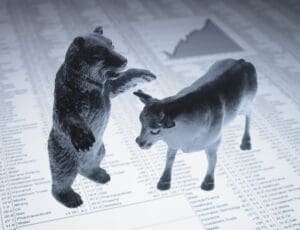Bull vs. Bear Markets – What Do They Mean?
What is a Bull Market?
A bull market is when prices of securities, such as stocks, are rising or expected to rise over an extended period. A bull market is typically characterized by an optimistic sentiment among investors, high trading volumes, and a general sense of economic prosperity.
Positive economic indicators, such as low unemployment, high consumer confidence, and strong corporate earnings often drive bull markets. In these environments, investors are generally optimistic about the future and are willing to take on more risk, creating a buyer’s market.
What is a Bear Market?
Bear markets occur when stock prices fall 20% or more over an extended period. A bear market is often identified by a negative outlook among investors, reduced trading activity, and overall economic pessimism.
In contrast to a bull market, a bear market can be triggered by adverse economic indicators, such as elevated unemployment, low consumer confidence, and weakened corporate earnings. During these environments, investors are generally pessimistic about the future and are more risk-averse, resulting in a seller’s market.
Remember…
Both markets can last for varying lengths of time, ranging from a few months to several years. While the stock market has experienced sustained periods of both growth and collapse, it has historically performed well. The most recent and longest bull market was from 2009 to 2019, following the housing crisis.
A bull market may be a favorable time for investors while bear markets can be challenging, but it’s important to remember that market cycles are inevitable and incredibly difficult to predict. In order to better weather the uncertainty, we recommend that investors utilize experienced asset managers who offer diversified portfolios that can weather the ups and downs of the market.

The term “bull market” comes from the image of a bull attacking its prey with an upward thrust of its horns, symbolizing the market’s upward momentum.
The term “bear market” comes from the image of a bear swiping its paws downward to attack its prey, symbolizing the market’s downward momentum.
Certain information contained in this communication constitutes “forward-looking statements”, which are based on Cambiar’s beliefs, as well as certain assumptions concerning future events, using information currently available to Cambiar. Due to market risk and uncertainties, actual events, results or performance may differ materially from that reflected or contemplated in such forward-looking statements. The information provided is not intended to be, and should not be construed as, investment, legal or tax advice. Nothing contained herein should be construed as a recommendation or endorsement to buy or sell any security, investment or portfolio allocation. Securities highlighted or discussed have been selected to illustrate Cambiar’s investment approach and/or market outlook and are not intended to represent the performance or be an indicator for how the accounts have performed or may perform in the future. The portfolios are actively managed and securities discussed may or may not be held in client portfolios at any given time.
Any characteristics included are for illustrative purposes and accordingly, no assumptions or comparisons should be made based upon these ratios. Statistics/charts may be based upon third-party sources that are deemed to be reliable; however, Cambiar does not guarantee its accuracy or completeness. Past performance is no indication of future results. All material is provided for informational purposes only, and there is no guarantee that the opinions expressed herein will be valid beyond the date of this communication.